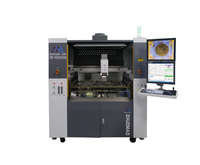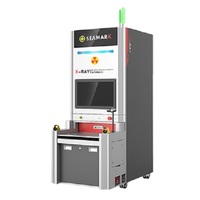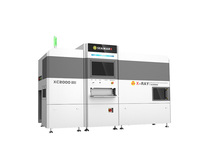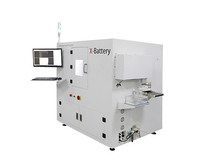CIC-D100 Ion Chromatograph for Halogen-free Detection Industry
Quick Detail
- Minimum order:1
Specifications
In terms of instrument analysis, ED-XRF (X-ray fluorescence spectrometer) and CIC (ion analyzer) are the most commonly used analytical instruments for analyzing halogen concentration. The X-ray
Fluorescence Spectrometer (XRF) uses the X-ray beam to irradiate the test piece to excite the elements in the test piece. When the self excited state of the atom returns to the ground state, it
detects the released fluorescence. After analyzing its energy and intensity through the spectrometer, it can provide the type and content of the constituent elements in the test piece. Ion
chromatography is an analytical method that uses the principle of ion exchange to separate the ions to be determined with different affinities between the mobile phase and the stationary phase,
uses conductivity detector to determine, determines qualitatively according to the retention time of each component, and uses chromatographic peak area to quantify. The detection limit can reach
the analytical level of ppb. At present, according to BS EN14582:2007 standard, oxygen bomb combustion uses ion chromatograph to analyze halogen.
1、General Design Principles Of Ion Chromatography Equipment And Edxrf Spectrometer
Following the lead-free process, a new wave of green electronics - Halogen-free will once again sweep the global electronics industry. In the Norwegian PoHS Act, which is about to be implemented,
18 kinds of harmful substances that must be excluded have been clearly regulated. The first group is brominated flame retardants, including hexacyclic bromidedecane (HBCDD) and printed circuit
boards. The most commonly used tetrabromopropanediol (TBBPA) and so on. In addition to the international laws that will be enacted successively, major international manufacturers including ASUS,
Dell, HP, Apple, Intel, AMD and other companies have also declared that they will introduce halogen-free materials from 2008.
Halogen materials refer to fluorine (F), chlorine (Cl), bromine (Br), iodine (I), (At) in the periodic table, mainly for the function of flame retardancy, and are widely used in electronic
equipment and other Accessories include machine boxes, printed circuit boards, cable wires, plastic parts and packaging materials. Electronic components and materials, bonding technology of
electronic products, product housing (Housing), PP, ABS, PMMA, PC..., plastics, pigments, etc.
The hazards of halogens are also well known. Organohalogen compounds can cause cancer in the human body, and their low biodegradation rate will lead to accumulation in the ecosystem. Some volatile
organic halogen compounds also have a great destructive effect on the ozone layer, which in turn affects the environment. Therefore, halogen compounds are listed as chemicals harmful to humans and
the environment, and their use is prohibited or limited.
2、Preface
Following the lead-free process, a new wave of green electronics halogen-free will once again sweep the global electronics industry. In the upcoming Norwegian PoHS Act, 18 hazardous substances that
must be excluded have been specified. The first group is brominated flame retardants, including hexacyclobromododecane (HBCDD) and tetrabromopropanol (TBBPA), which are most commonly used in
printed circuit boards. In addition to the international laws that will be enacted in succession, international manufacturers including ASUS, Dell, HP, Apple, Intel, AMD and other companies also
announced that they will import halogen-free materials from 2008.
Halogen materials refer to fluorine (F), chlorine (Cl), bromine (Br), iodine (I) and (At) in the periodic table. They are mainly used for flame retardancy and are widely used in electronic
equipment and its accessories, including machine boxes, printed circuit boards, cable wires, plastic parts and packaging materials. Electronic components and materials, bonding technology of
electronic products, housing, PP, ABS, PMMA, PC..., plastics, pigments, etc.
The hazards of halogens are also well known. Organic halogens can cause cancer in the human body, and their low biodegradation rate will lead to the accumulation in the ecosystem. Some volatile
organic halogens also have a great destructive effect on the ozone layer, thus causing serious impact on the environment and human health. Therefore, halogens are listed as chemicals harmful to
humans and the environment, and their use is prohibited or limited.
International specifications such as halogen materials
From Freon to POPs, from PVC to brominated flame retardant (BFR), it is an indisputable fact that organic halides are harmful to human body and natural ecological environment. The Montreal Protocol
signed in 1987 and the Stockholm Convention signed in 2001 show that countries around the world have restricted the production and use of such substances. In recent years, the well-known EU
Directive on the Prohibition of Electrical and Electronic Hazards (ROHS Directive) stipulates that bromine flame retardants will be banned from July 1, 2006. At the same time, there are a series of
international laws and regulations prohibiting the use of some toxic and harmful halogenated organic solvents on electronic appliances, toys and leather products, including the prohibition of use
in the production and processing process, the prohibition of residues in the final product, and the limitation of volatile halogenated organic substances in the final product.
International organizations or large manufacturers such as IEC, IPC, JPCA and Samsung have defined the specifications of their halogen-free materials. The IEC 61249-2-21 specification requires that
the content of bromine and chloride must be less than 900 ppm, and the total halogen content must be less than 1500 ppm. The definition of halogen-free materials in IPC is the same as that in IEC;
The JPCA specification defines that the limit of bromide and chloride content is 900 ppm, and does not require the total halogen content. Samsung stipulates that the content limit of bromide and
chloride is 900 ppm respectively.
Ion chromatography analysis method:
1、 Sample treatment: oxygen bomb burning or oxygen bottle burning
2、Ion chromatograph:
CIC100 standard ion chromatograph
According to WEEE directive and IEC/EN1249-2-21 standard, only when the bromine ion content in PCB substrate does not exceed 900 PPM, the chloride ion content does not exceed 900 PPM, and the
bromine+chloride ion content does not exceed 1500 PPM, can PCB be called halogen-free.
Test standard: EN14582 or IEC61189-2006. Ion chromatography is recommended internationally for detection, and oxygen bomb combustion conversion is recommended for pretreatment. Take CIC100 ion
chromatography as an example:
2、Practical Application Report
Overview: Halogens (fluorine, chlorine, bromine, iodine) are added to polymer products such as plastics to improve the ignition point. Its advantages are: the ignition point is higher than that of
ordinary polymer materials, and the ignition point is about 300 ℃. During combustion, halogenated gases (fluorine, chlorine, bromine, iodine) will be emitted, and oxygen will be quickly absorbed to
extinguish the fire. However, its disadvantage is that when the concentration of chlorine released is high, the visibility will be reduced, which will lead to the inability to identify the escape
path. At the same time, chlorine has a strong toxicity, which affects the respiratory system of people. In addition, the halogen gas released from the combustion of halogenated polymers will
generate corrosive harmful gas (hydrogen halide) when combined with water vapor, causing corrosion to some equipment and buildings.
Brominated flame retardants, such as PBB, PBDE, TBBPA, are widely used in electronic and electrical industries, including circuit boards, computers, fuel cells, televisions and printers.
These halogenated flame retardant materials produce dioxins when burning, and can exist in the environment for many years, or even accumulate in organisms for life, and cannot be discharged.
At present, different products have different limit standards for halogen-free requirements:
For example, the halogen index of halogen-free wires and cables is: the value of all halogens ≤ 50PPM
(according to the regulation PREN 14582); Content of hydrogen halide gas generated after combustion < 100PPM
(according to EN 5067-2-1); PH value of hydrogen halide gas generated after combustion after being dissolved in water ≥ 4.3
(according to EN-5 0267-2-2); The light transmittance of the product after burning in a closed container is ≥ 60%
(according to EN-50268-2).
Detection and analysis spectrogram of halogen in plastics:
The above figure shows the detection spectrum of halogen content in a packaging plastic, corresponding to F -, CL -, Br -, I -, four halogen ions. It is a convenient and fast international standard
analysis method, which can complete the analysis and detection within 20 minutes after one sample injection.
3、 Technical Description
1. High pressure pump with wide range, high performance and low pulse double flow reviving plug is used, and the pump speed reaches 9.999ml/min
2. It can support a variety of anion/cation chromatographic columns at home and abroad, with high reliability and stability, accurate flow and low maintenance Equal advantages
3. The advanced online degassing technology can conduct real-time degassing control for the mobile phase, avoiding the tedious operation and intermittence of the traditional degassing pump.
4. The advanced continuous automatic regeneration membrane suppressor has high inhibition capacity, no need to use a peristaltic pump, fast balance, anti pollution, good repeatability, no need to
use any consumables, and zero maintenance.
4、 Technical Standards And Specifications
The design and manufacture of ion chromatograph shall comply with the national standard. The main design and manufacturing standards and specifications are as follows: (List the standard number and
standard name)
7、 Pre Processing Operation
Oxygen cylinder combustion method
1、Oxygen cylinder combustion method:A 500mL iodine measuring bottle is connected with a section of platinum wire with spiral lower end at the center of the grinding plug. The diameter of platinum
wire is about 1mm (see the figure below)
2. Shape of sample wrapping paper for oxygen flask combustion method (ashless filter paper)
1、 Sample pretreatment steps:
1. Cut 0.5-2.0g sample according to the expected amount of halogen, and cut it into small pieces less than 1mm on each side.
2. Weigh 40~50mg sample, accurate to 0.1mg. If the halogen content is known to be small, several samples can be burned continuously on the same absorption solution in the same absorption bottle.
The samples are wrapped with filter paper, sandwiched in the spiral platinum wire, and the leaching solution (30-50ml) is added in the oxygen combustion bottle.
3. Put it in the safety cover. Connect the oxygen cylinder and apply oxygen at a flow rate of at least 2L/min for 1min. When the combustion cylinder is filled with oxygen, ignite the end of the
filter paper of the package sample, quickly disconnect and open the oxygen system, cover the bottle plug, and press it tightly by hand. It can be removed from the safety cover only after the flame
is extinguished. There should be no black ash residue in the bottle.
4. Park for about 10min, open the bottle stopper, and rinse the bottle stopper and platinum wire with appropriate amount of eluent.
2、 Operation steps of ion chromatograph
1. Transfer the absorption solution to a 100ml volumetric flask and fix the volume. 2. The sample is analyzed by ion chromatography. We will provide on-site installation training for professional
technicians, which is a very simple process and lasts for 3-5 days.
Seamark ZM is a professional ion chromatography instrument manufacturers . We provide bga x ray machine, x ray pcb inspection machine, ion chromatography machine and etc. Want to know ion
chromatography instrument price and more about bga rework, contact us.





